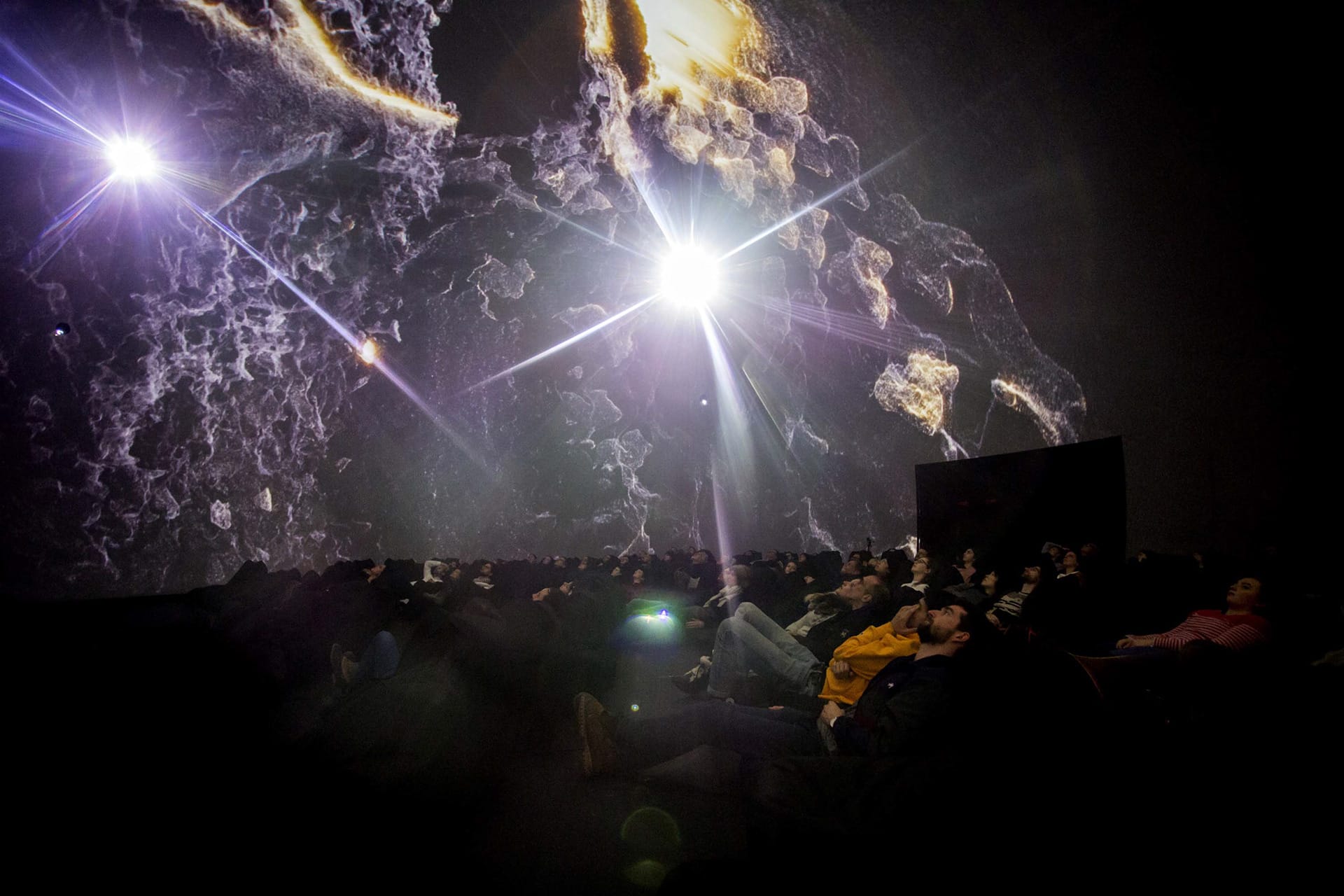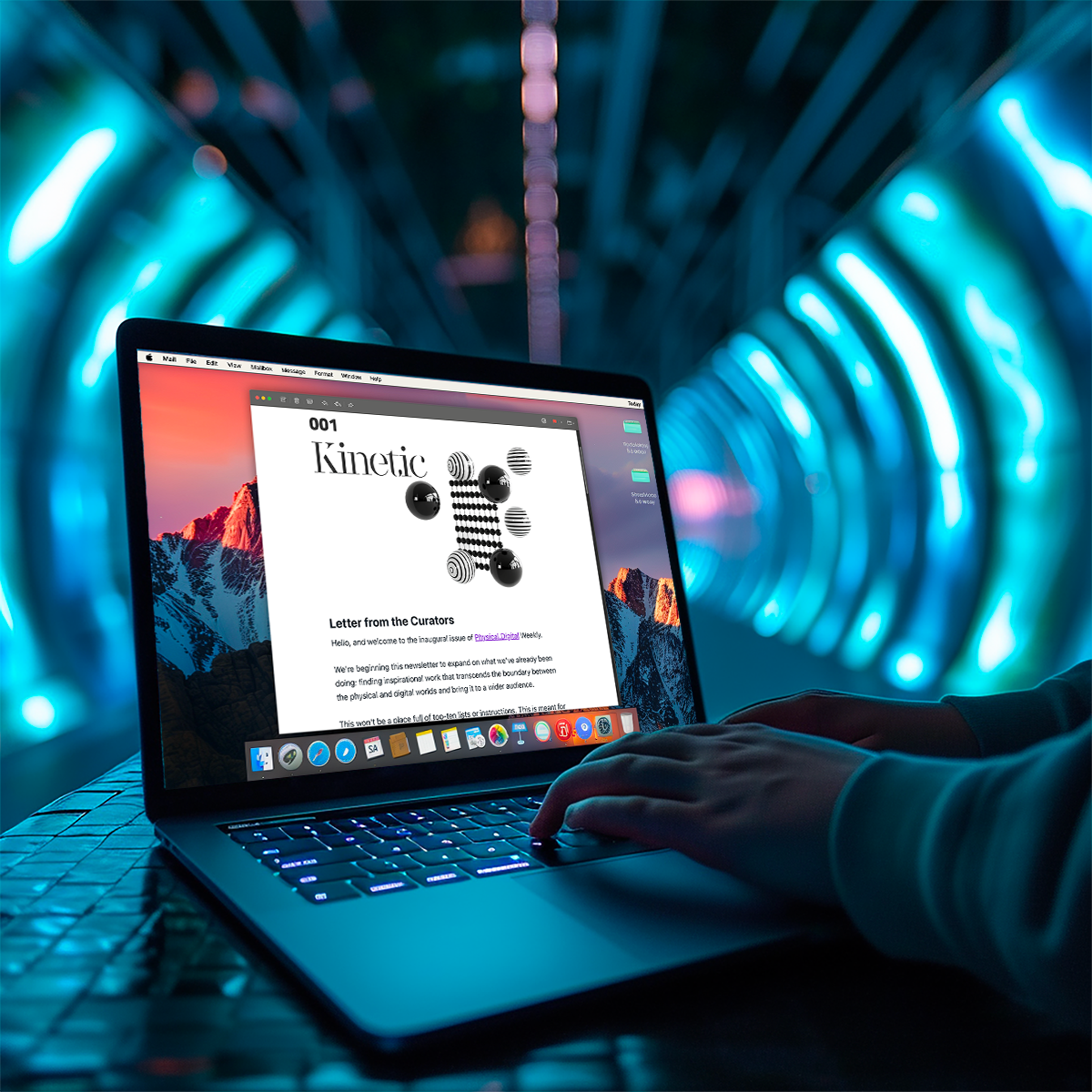Sébastien Labrunie

A conversation with
Sébastien Labrunie
A mixed-media collage artist working in immersive domes, Sébastien talks process, AI, and prototyping.

For years, you’ve been using immersive domes for your installations, do you see these spaces becoming more common in the near future? Do you prefer the physical space over something like VR?
I've actually moved away from VR for now. The domes are more of a social experience...
Yeah, I think they will be more common, but I also think we will bring new life into old planetariums, which are starting to do contemporary art more and more. I really love the format because a sphere is the maximum immersive space you can get, and I’ll be focusing on them more since it's getting more accessible and even new spaces are being built.
Its format is also great to teach immersive techniques because it’s more straightforward. It's one file, a single fisheye, full dome master, which is easier than working with projection on many walls and floors.
I've actually moved away from VR for now. The domes are more of a social experience, which is way more compelling to me to be with actual people instead of in an enclosed headset. I mean, I enjoy VR. I just prefer the scale and organic light of domes, like being in a large movie theater.

What have been some of your learnings using those non-traditional platforms?
You can play with scale—make it seem as though you’re in a cocoon, or an optical illusion that feels like you’re moving through space. In domes you can push visual distortions and play with the senses. It’s more intense in a dome because of how peripheral vision works. But, you have to experiment more with the optical illusions when you’re working in a dome.
How do you prototype for domes vs. other platforms?
It's completely different. My first piece in a dome, I never actually tested in the dome. I just worked on the fisheye perspective and didn’t even test it in VR, so it was interesting to see it in person and understand the point of focus is a bit tilted, and not how you design it. It’s something you learn when you get into the dome and you have a chance to work inside.
I mainly use VR for testing now. I’ll sit in a fake dome, choose my seat, and just experience. I’ll work on a sequence and try to make it accurate, but then I also like to reach beyond it and distort it, to be surprised by it.
Usually I work instinctively and use a collage approach. So let's say for example, you have a 180 degree dome, you can design it precisely and configure the fisheye camera to be exactly that size, but I personally try to push beyond this. So sometimes I’ll use a 360 degree view inside of a 180 degree dome to intentionally distort the point of view.
You've talked previously about the relationship of your work to storytelling, and that your approach is more of an abstract narrative. Is this true for something like Angstrom which has distinct chapters?
I have a starting point and an ending point...but I also want to be surprised.
There’s a narrative, I have chapters, but it’s more like short films triptych. I have a main theme in mind, symbols, and chapters, and then try to merge theme together. I had a big chapter in my mind about this tree which was a symbolic part of my parents place when I was a kid.
I have a starting point and an ending point, and I know there should be a couple of chapters, but I also want to be surprised. I want there to be room for the audience to come up with their own interpretation. I don’t try to control all aspects.
What was your journey to reach the place you are now in your career, and what advice would you have for those just starting out?
A long, long time ago I was a graphic designer in France. It was the early days of VR, I remember playing with my phone and the plastic adapters that strapped to you forehead. It was fun but tough on the eyes!
Learn by yourself, and don’t be scared by all the tools—sometimes you need just one to get started.
I went to Taiwan and live in Taipei for five years. I was growing bored with graphic design and so moved to video games, in a new era of VR, similar to what we’re in now. I joined a startup that received funding from HTC to do a spatial music sequencer called Lyra VR. So I was doing video games, then I met sound artists in Taiwan that were doing experimental Noise, and I've performed with the sound artist Lu Yi many times there. Through that, I discovered and started using TouchDesigner for live audiovisual shows. From there, I moved to immersive visuals, but it was definitely a long journey to learn all the tools. My first immersive piece was only in 2019, so pretty recent.
I’m actually running some workshops to teach what I’ve learned, and I would suggest you must consider there are many tools, and don’t go all in on one thing. Don’t limit yourself. You don’t really need a super expensive computer to do immersive films, you could even just use a smartphone as your main camera for cinematic shots and photogrammetry. Learn by yourself, and don’t be scared by all the tools—sometimes you need just one to get started.
"We are Nature" is an echo of transformed nature, struggling to preserve its original form.
What do you see as the future of physical digital convergence?
I would love to see more organic shapes of screen, more flexibility, more haptic, etc. Nano screens taking any shape would be great to go beyond just the flat screen, and being able to map an entire space. Screens becoming flexible, like fabric, would be fun to play with. It’s similar to mapping, but without the hassle of having a light beam and shadows.
What are you views on AI as part of the creative process?
I actually use some AI in Angstrom, I merge generated pictures into actual footage from the camera. If you’re using it to get generic logos, that’s one thing, but use the tools and see where it leads. It’s pretty magical, but double sided.
It will be “fast food video” at some point. If you want to see cats everyday doing weird stuff and talking to you, you will have it. It’s a weird space. For the first time, two days ago, a YouTube video ad popped up and I then realized “oh, that’s not a real person!”
And it’s happening so fast. I thought we’d have generative pictures for years before video, but now Sora is coming out. I wasn’t prepared. So what's gonna be next? I don’t know…generative video games? 3d models? Fully generated TV series with pay-per-actor premium options?
Å N G S T R Ö M is an immersive surreal experience in 3 chapters.
What else is inspiring you outside of what people might expect?
Old alchemy books, and I'm a big fan of the surrealist period. I enjoy working with old CRT TVs and analog video synthesis because I love being able to influence the electrical signal and play with light and colors organically, being able to glitch it and distort it. I sometimes focus on analog techniques, and I'm often influenced by surrealist movement approaches, trying to transpose them into new mediums and digital workflows.
MILAMUGSIT means a multitude of colors in Mi'kmaw language. This piece takes a fresh look at the city through its raw colors.

